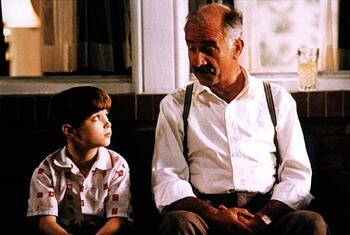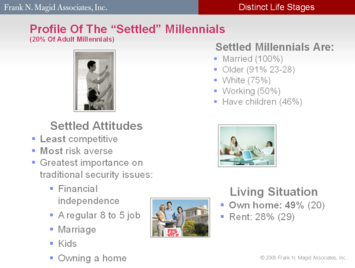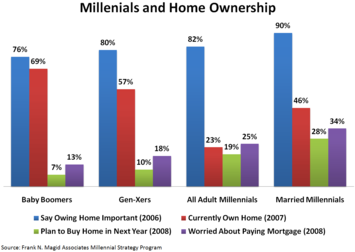
By Morley Winograd and Michael D. Hais
In his autobiographical film, “Avalon,” Barry Levinson captured what he believed to be the impact of America’s suburban exodus on his large and fractious family. He suggested that the weakening of the ties that bound his previously close-knit family was due to its dispersal to the suburbs rather than the social upheavals of the 1960s that he captured so well in the other two films in his Baltimore trilogy – “Diner” and “Liberty Heights.”
It is true that from 1940 to 1960 the percentage of Americans living in suburbs doubled – from 15 to 30 percent. However, the weakening of family ties, as measured by such social indicators as rising teenage crime and pregnancy rates and declining school test scores just after that period of rising suburbanization, had more to do with the cycles of generational archetypes than the place where American families lived and were raised. Members of the Silent Generation, like Levinson and the two of us, as well as the older GI Generation, battled with the new, idealistic values of their Baby Boomer children. The intergenerational tensions, captured popularly and colorfully in the TV sitcom, “All in the Family,” simply overwhelmed the idyllic picture of American family life in the 1950s.
But, these, like all generational trends, are cyclical. The very same generational forces that pulled American families apart in the late 1960s and 1970s, are about to return full circle to the attitudes and beliefs of a “civic” era very much like those of the 1950s and early 1960s, the golden years in Levinson’s memories. Millennials, born between 1982 and 2003, members of the largest, most diverse and newest "civic" generation in American history are becoming adults, entering the workforce, getting married and settling down. Civic generations, like Millennials and the GI generation of the 1930s, believe in adhering to social rules, care deeply about the welfare of the group, and tend to create stable, law-abiding communities as they mature. As a result, where and how Millennials choose to live and raise their families will be the single most important force in shaping America’s housing and communities for the next two decades.
Like their civic GI Generation grandparents or great grandparents, Millennials have a deep and abiding interest in the communities in which they live and participate. As Millennials grew up, this interest in forming communities was both enabled and demonstrated by the enormous popularity of social networks, such as MySpace and Facebook. Over eighty percent of all Millennials have a personal site on at least one of these networks, through which they interact and plan their activities with one another on a constant and ongoing basis.
This desire to connect to their friends and, at the same time, build better communities is also evidenced in the strikingly high volunteer participation rates of Millennials, especially in comparison to those of their older Generation-X siblings or parents. Eighty percent of Millennials performed some sort of community service while in high school, triple the rate of high school-aged Gen-Xers back in the 1980s. Not only do seventy-percent of college-age Millennials report having done voluntary community service, but 85 percent of them also consider it an effective way to solve the nation’s problems.
It is no coincidence that, during the week leading up to the 4th of July, America's most important civic holiday, Senator Barack Obama, the presidential candidate with the greatest demonstrated appeal to Millennials, issued a call for mandatory programs of community service for high school and college students. As was the case with the civic GI Generation six decades ago, Obama proposed that this service be rewarded with financial assistance to help pay for higher education. In Obama's words, community service “will be a central cause of my presidency.”
The first initial indications of how this sense of community will impact the behavior of Millennials as they enter young adulthood are now becoming available. They contain good news for America’s suburbs and for those remaining in family-oriented neighborhoods in our nation’s cities.
 One thing seems clear: Millennials generally lack the animus against suburbs that have been a major element of Baby Boomer urbanist ideology over the past few decades. According to survey data from Frank N. Magid Associates, America’s leading entertainment and media research firm, young Millennials already reside in the suburbs to at least the same extent as members of older generations. The Magid data also suggest that this residential preference is not likely to change as the Millennial Generation matures and "settles down." Once Millennials marry their firm preference is to live in a single-family home, and not in a typical urban setting of lofts, condos or apartments. Almost half of “settled” Millennials (those who are married, many with children) own their home. Only about a quarter are renters.
One thing seems clear: Millennials generally lack the animus against suburbs that have been a major element of Baby Boomer urbanist ideology over the past few decades. According to survey data from Frank N. Magid Associates, America’s leading entertainment and media research firm, young Millennials already reside in the suburbs to at least the same extent as members of older generations. The Magid data also suggest that this residential preference is not likely to change as the Millennial Generation matures and "settles down." Once Millennials marry their firm preference is to live in a single-family home, and not in a typical urban setting of lofts, condos or apartments. Almost half of “settled” Millennials (those who are married, many with children) own their home. Only about a quarter are renters.
Virtually none of the "settled" Millennials still reside with their parents or other relatives. This represents a significant difference from the status of Millennials of about the same age (mid-twenties) who are working, but single. About half of this latter group rent their home, either alone or with others, while only 13 percent are homeowners. About a quarter of the unmarried Millennials live with their parents, which often earns them disdainful comments from older generations. Early evidence seems to suggest that this “return to the nest” phenomenon has more to do with the economics of graduating from college with large student loans unpaid and entry level pay than it does to any lack of energy or unwillingness to accept adult responsibilities. It also has to do with one of the defining characteristics of Millennials: they get along better with their parents than either Boomers or Gen-Xers.
This generational trait is especially important for the future of America’s suburbs. Unlike Baby Boomers and Gen-Xers, Millennials tend to be friends with and enjoy staying connected to their parents, if not in person than on a constant basis on cell phones or the Internet. In contrast, during the 1960s and 1970s, Boomers moved as far away as they could from their parents' home in order to “find themselves” and express their own unique values. In the 1980s and 1990s, Gen-Xers often reacted to their relatively unloving upbringing (think “Married…with Children” vs. “Leave it to Beaver”) by rejecting every aspect of their childhood, including leafy lawns and spacious suburban housing. By contrast, Millennials actually like and respect their parents, and often prefer to live as their parents do, preferably in a place that's close to their parents.
 America’s love of suburban living is continuing unabated long after the time in American history captured so poignantly in “Avalon.” In the 1970s, racial tensions and the general deterioration of central cities pushed more Americans into the suburbs. A plurality (38%) lived in the suburbs as early as 1970 and 45 percent did so by 1980. In 2000, around the time the last members of the Millennial Generation were being born, fully half of all Americans were living either in older suburbs or the new exurbs beyond them. Despite the problems posed by high gas prices and the mortgage crisis, suburban growth is still outpacing that of both urban and rural areas, as not only homeowners but also businesses continue to locate in the suburbs. The desire of Americans for their own plot of land likely will continue well into the 21st century as well.
America’s love of suburban living is continuing unabated long after the time in American history captured so poignantly in “Avalon.” In the 1970s, racial tensions and the general deterioration of central cities pushed more Americans into the suburbs. A plurality (38%) lived in the suburbs as early as 1970 and 45 percent did so by 1980. In 2000, around the time the last members of the Millennial Generation were being born, fully half of all Americans were living either in older suburbs or the new exurbs beyond them. Despite the problems posed by high gas prices and the mortgage crisis, suburban growth is still outpacing that of both urban and rural areas, as not only homeowners but also businesses continue to locate in the suburbs. The desire of Americans for their own plot of land likely will continue well into the 21st century as well.
The community- and family-orientation of the Millennial Generation will only reinforce the continued growth of America's suburbs. Levinson’s experience growing up with his extended family in a tight-knit urban ethnic neighborhood will likely never return in quite the same way. After all, America’s rising ethnic minorities are also moving heavily to the suburbs as well as to remaining family-friendly moderate-density neighborhoods closer to the city.
Yet the suburban tilt of this migration does not mean that communities sharing the joys of family and friends that Levinson longed for have become extinct. The main difference is that this time, most Americans will share that experience, not in central city ethnic enclaves, but in suburbs or moderate density urban communities with houses located conveniently to their work – if not actually in their Internet-wired home. This return to “Avalon” will occur thanks, in large part, to the civic spirit and community orientation of America’s next great generation, the Millennials.
Morley Winograd and Michael D. Hais are co-authors of “Millennial Makeover: MySpace, YouTube, and the Future of American Politics,” published by Rutgers University Press.













I would like to thank you
I would like to thank you for the efforts you have made in writing this articl
harga honda jazz 2015
Packers and Movers India
Thanks for post this helpful post - Please visit for More information about -
Packers and Movers in Hyderabad
Packers and Movers in Pune
Packers and Movers in Mumbai
Packers and Movers India
Thanks for post this helpful post - Please visit for More information about -
Packers and Movers in Chennai
Packers and Movers in Delhi
Packers and Movers in Bangalore
Packers and Movers in Gurgaon
Packers and Movers India
Thanks for Nice and Informative Post. This article is really contains lot more information about This Topic. -
Packers and Movers in Noida
Packers and Movers in Thane
Packers and Movers in Navi Mumbai
Packers and Movers in Ghaziabad
Packers and Movers in Faridabad
Wonderful article, thanks
Wonderful article, thanks for putting this together! This is obviously one great post. Thanks for the valuable information and insights you have so provided here.
http://www.textmate2.org
I really appreciate the kind
I really appreciate the kind of topics you post here. Thanks for sharing us a great information that is actually helpful. Good day!
rebelmouse.com/michaelfioresecretsurveyreview/
Pretty good post. I just
Pretty good post. I just stumbled upon your blog and wanted to say that I have really enjoyed reading your blog posts. Any way I'll be subscribing to your feed and I hope you post again soon. Big thanks for the useful info.
sold exclusively online
I high appreciate this post.
I high appreciate this post. It’s hard to find the good from the bad sometimes, but I think you’ve nailed it! would you mind updating your blog with more information?
safetyjogger
Awesome and interesting
Awesome and interesting article. Great things you've always shared with us. Thanks. Just continue composing this kind of post.
http://rebelmouse.com
I am happy to find this post
I am happy to find this post Very useful for me, as it contains lot of information. I Always prefer to read The Quality and glad I found this thing in you post. Thanks
ways to make any girl want you